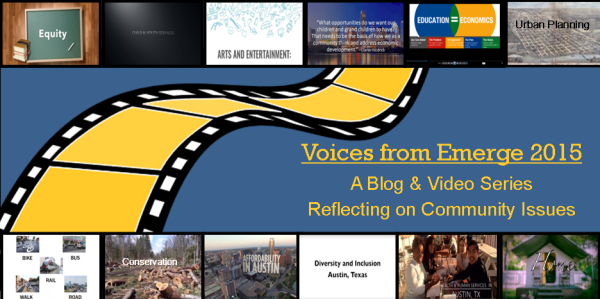
Guest Post from 2015 Emerge Graduate Natalie Smith.
Natalie is an Independent Contractor at Beatty Bangle Strama PC.
This video on Affordability was prepared by a team who examined aspects of this issue in our community. Please take a minute to watch.
When it comes to affordability and living in Austin, the struggle is real for all too many. Living within the Austin City limits is becoming less and less affordable for many residents by the day. This is concerning for many reasons, but especially because it is affecting the richness and diversity of our beloved city.
I knew Austin was becoming a more expensive city in which to live when I returned after a decade of living on the East Coast and did not find the huge savings in rent I was expecting. And when you’re struggling to find an affordable place to live, you can feel isolated from the Austin that’s on all the Top 10 lists that we read about so often. What I did not know was how many other people were experiencing the same sticker shock related to housing costs and how many people were barely getting by or being forced to move out to surrounding communities to find affordable housing. Affordability isn’t something that’s limited to young professionals like myself or even people with low paying jobs, as many assume. Affordability in Austin is something that affects people of all different ages, races, ethnicities, and socioeconomic statuses in the city. It affects your friend who is a college-educated millennial with full-time employment who is back living with her parents because she can’t afford a place of her own along with a car and all the other costs of life. It also affects baby boomers who have lived in the city for decades and who now worry about whether they will be able to afford to remain in Austin after they retire.
One astounding statistic that I recently learned in my Leadership Austin Emerge class is that a quarter of renters spend half of their income on housing. Half. This may be due in part to the fact that housing costs in Austin have increased 85% over the last 10 years. This statistic is huge when you consider how closely affordability is tied to housing. And how housing is tied to employment, education outcomes, economic development, neighborhood stability, and security. Where one lives impacts access to high performing schools, sustainable jobs, comprehensive healthcare and success. Where you can afford to live impacts all facets of your life and too many Austin residents are finding there isn’t a place they can afford in this growing city.
While I do not know what the solution is to Austin’s affordability problem, I do know that it is not going away any time soon and we all need to engage with our city leaders, with developers, and within our neighborhoods to find solutions. This video put together by my classmates closes with a strong and direct call to action. Join with me in following their lead. Austin won’t remain the city that we all love if the cost of living the Austin life is out of reach for so many people who make Austin Austin.
NOTE: The opinions of Leadership Austin alumni, faculty members, and guest bloggers are their own, and do not represent an official position of the organization.
 Interested in the 2016 Emerge Class?
Interested in the 2016 Emerge Class?
Recruiting dates have been announced.

